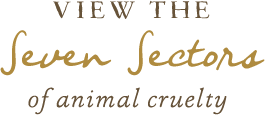Clothing: If Looks Could Kill
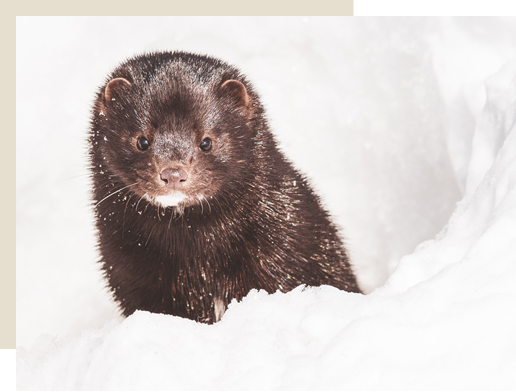
Humans are the only animal species that wear clothes (we’re not counting chihuahuas in tutus or terriers in knit sweaters, guys). While other species have fur, feather, and scales to protect them from the elements, we got stuck with skin that burns in the heat and freezes in the cold. Clothing is a necessary part of our survival, but too often our clothing choices hurt the survival of our animal companions.
The fashion industry is known for always changing. Corsets come, shoulder pads go. One day you’re rocking platform flip flops and low-rise jeans, and the next day you’re cringing at your middle school photos. While society seems to have accepted the fickle nature of the fashion world, we also seem to have accepted the darker side of clothing production.
Many people have something in their closet made from leather, wool, down, silk, or fur. Some intentionally buy fur items as a status symbol
(because nothing says wealth and glamour like wearing the skin of a former living creature?). Others may have no clue that a pregnant sheep was violently killed and her newborn turned into the “Persian wool” they’re wearing. Why do we seem to consider luxury items the ones that cause the most suffering?
While fashion magazines continue to milk us of our money with never-ending trends, millions of animals are raised each year in inhumane conditions. They are then killed in the prime of their miserable lives to be worn as coats, hats, belts, purses, shoes, and whatever else the fashion industry tells you is a must-have. As if crocodile leather shoes are as essential to your survival as air, water, and food.
At some point in history, a fur coat may have been the only way for a human to survive the tundra. Survival was one thing. But getting rich off the misery and pain of animals is a violent fashion statement, and showing off your style with an animal’s unnecessary death is no longer in season. Today there are so many wonderful alternatives to leather, wool, down, silk, and fur, which are cruelty free and sustainable for people and the planet. We encourage you to download our complementary cruelty free shopping guide and find your personal flair without harming animals. Lucky for us, compassion never goes out of style.
Food: Kindness. It’s what’s for dinner.

There is a moment in many children’s lives when they realize that chicken and chicken are the same thing. Old MacDonald has a chicken who says “cluck cluck.” Chicken is what grandma serves you in a pot pie or what comes out of a fast food bag and smells delicious. Upon realizing that the two chickens are in fact the same creature, some kids may be horrified and swear to a lifetime of veganism. Others may go on eating chicken. They’ll savor the taste and shrug their shoulders, accepting the way our society normalizes the adoration of some animals and the abuse of others. In mainstream US culture, children will be taught through commercials, media, and school lunches that eating animals and consuming animal products is totally normal. But some kids quickly learn that normal does not always mean moral.
If Old MacDonald sung about what really happened to animals in the food industry, children would be traumatized for life. Old MacDonald’s dog gets belly rubs and kibble, while his cows are forcibly impregnated, painfully separated from their young, trapped in crates too small to turn around in, and slaughtered in the prime of their miserable lives. We would never be that honest in a nursery rhyme.
Instead we soften our society’s cruelty for children, singing songs where the animals roam and ramble, free and loved. We shield them (and ourselves) from the truth behind their beloved chocolate milk. By the time they grow into adults, some will believe the stories and songs they were given and pass them down to their own offspring. They’ll recreate grandma’s recipes and feed their children meat and dairy, without thinking twice. At the same time, they’ll throw their dog a birthday party and get a commemorative oil painting of their cat. When other intelligent, emotional, and wise animal communities are being exploited and submitted to painful, pleasureless lives, they won’t question it. They’ll just take another bite.
Whether we face these hard truths or continue to hide behind nursery rhymes, the heavy toll of animal agriculture is going to catch up with us. Numerous scientific studies share the lifelong benefits of a vegan or vegetarian diet and the health risks associated with eating animal products. On top of that, agricultural animal production is one of the top contributors to water, air, and soil pollution, which makes supporting this industry even less appetizing. Next time you reach for a glass of milk, chicken nugget, or hamburger, ask yourself one question. What would Old Macdonald
say if he were making compassionate and honest food choices? Here a no, there a no, everywhere a no, no!
When all signs point to a plant based diet, say yes to kindness and informed compassion. We promise, it tastes amazing.
Animal Testing: The Ugly Truth About Beauty
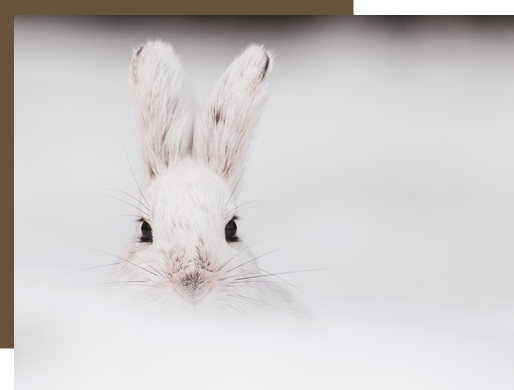
Your beauty routine shouldn’t be ugly. We’re not talking about the wrong shade of lipstick for your skin tone or tried to do winged eyeliner for the first time and
ended up looking like a punk rock racoon instead. We’re talking about the ugliness of using animal testing in the creation of beauty products.
The Human Society estimates that 100,000 — 200,000 animals suffer and die at the perfectly-manicured hands of the cosmetic industry every year. Some of our most beloved pets — rabbits, hamsters, guinea pigs, rats, and mice — are killed through the testing of cosmetic, skincare, and household products. Common practices include rubbing chemicals into shaved patches of animals’ skin, dripping chemicals into their eyes, or force-feeding them for months. You won’t see those horrors in some vaguely tropical commercial trying to sell you shampoo. Cosmetic companies don’t advertise that some of their latest! and greatest! products were formulated with lethal dose tests, where animals are continuously fed chemicals until they die, determining the fatal limit that can be ingested.
The ugliest, most sickening part of all? Animal testing is not necessary for most cosmetic products in the US. Nope. When there are already thousands of ingredients that are well-tested and considered safe for general use, the cosmetic industry has no excuse to keep up this heinous practice. Some companies still choose to test on animals because they want to use new ingredients, or they want to sell their products to overseas markets where animal testing is still required. But this is a willing choice they make, and that choice is even grosser than the fluorescent orange eyeshadow of the 80’s.
There have been incredible efforts on the parts of animal rights activists and scientists to find alternatives to animal testing. 3D models of human skin and advanced computer programs have been created to test for the possibility of skin corrosion or irritation — and they can be more effective than animal testing!
So that means you can enjoy the wonders of civilization — deodorant, shampoo, a lipstick that matches your complexion, and that perfect winged eyeliner — all while shopping cruelty-free. And what could be more beautiful than that?
Animals in Entertainment: Dysfunctional Fun
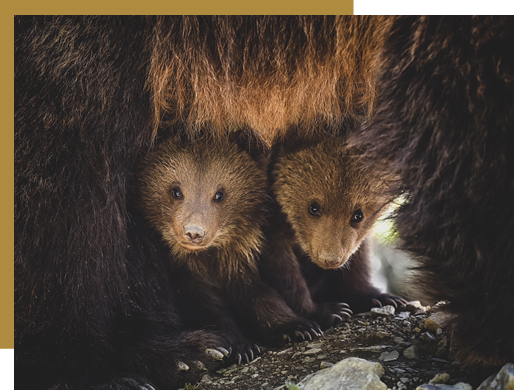
If you’ve ever played a game of Monopoly with your family, you’ve seen how an innocent board game can quickly turn into a gladiator ring. What started out as “bonding time” ended with Grandma owning Boardwalk and talking trash, your cousin flipping the board, and your aunt and uncle threatening divorce every time they go bankrupt. What can we say? We put the “fun” in dysfunctional? Unfortunately there’s no better example of human’s love for dysfunctional amusement than the use of animals in the entertainment industry. Masquerading as light-hearted family fun, circuses, animal races, zoos, and other forms of animal entertainment can be horrifically cruel industries.
In circuses, wild animals are conditioned through violent training to perform unnatural acts. On the open savanna, you would find elephants bonding with their families and scavenging for food, not twirling on their hind legs and giving rides to screaming children. Their circus “tricks” are the result of breaking down the animal’s natural instincts, a process that involves abuse like hitting the elephants with bullhooks or electric prods everytime they make a mistake.
Some cruel games don’t even pretend to be anything else. Blood “sports” like bullfighting, rodeos, cockfighting, and dogfighting put their viciousness on full display. Animals are raised in isolation and confined in choking spaces. They may be injected with steroids to increase aggressiveness. Their bodies are maimed to make them more efficient fighters. Their entire purpose in life is to make their human “fighters” money by killing their opponent.
While animal races are not as publicly cruel as blood sports, the animals are still treated as money-makers instead of living creatures. More horses and dogs are raised to be race animals than the industry “needs,” so they are bred and then quickly slaughtered. Just to sustain some man’s gambling addiction and some rich lady’s obnoxiously big Kentucky Derby hat.
Our “fun” doesn’t have to be dysfunctional. Money can still be made and fun can still be had without other living beings unnecessarily suffering. There are plenty of alternative, cruelty-free ways of experiencing the thrill of the wild. Instead of exploiting animals from other parts of the world, get to know the animals in your own backyard or nearest park. Try bird-watching, nature photography, or visits to a wildlife sanctuary (just check that they’re a nonprofit with a no-breeding policy). Find ways to appreciate animals in their natural habitats, where they are free to express their full personalities and wild nature.
Domestic Animals: Fur Children
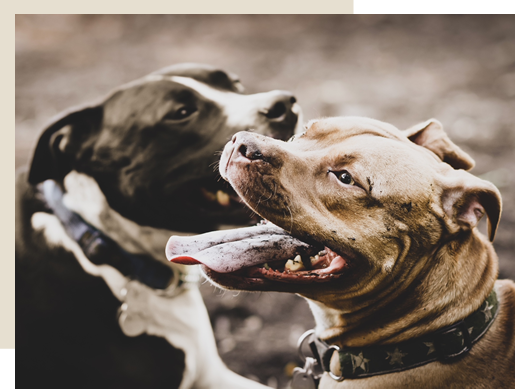
Raise your hand if you know someone who treats their pet like an actual child. Using a baby voice every time they talk about their dog or cat or boa constrictor, showing you endless pictures of their fur babies, throwing birthday parties, that sort of thing. Some people have such an intense bond with domesticated animal that it even outshines the love some people have for their real, human children. A celebrity’s dog got a Bat Mitzvah and someone else’s kids got chopped liver.
In all seriousness, the way we treat animals is often a reflection of how we have been treated. It is far too easy for many people to get caught in a cycle of violence, where they inflict on animals the same abuse that has been inflicted on them. In many domestic violence cases, animals in the home are the first ones abused. Children are the perpetrators in one fifth of all animal abuse cases, which is often a telltale sign that the children themselves are being abused (Animal Legal Defense Fund).
Domestic animal abuse puts a spotlight on the complex relationship between humans and animals perhaps more than any other animal rights issue. In many cultures, we consider pets to be markedly different from other animals. We believe they are smarter, more aware, and capable of love in a way that other species aren’t. The more we study animal intelligence, the more we learn this isn’t true. The fact is we have evolved alongside domestic animals for thousands of years, which means they have come to depend on us. Like children, they are helpless against our abuse, starvation, cruelty, and neglect. Like children, they can be tremendously curious, playful, and affectionate when they are given love and security.
If you aren’t ready to take care of a child, you aren’t ready for a pet. If you can’t take care of a pet’s survival and well-being, you aren’t ready to be a parent. If people could follow those guidelines, cases of animal abuse and domestic violence would dramatically decrease. While many of our featured organizations (like The Animal Hope and Wellness Foundation and the Best Friends Animal Society) do amazing work to protect domestic animals from abuse, the problem will never completely fade until our society confronts its never ending cycles of violence. Our violence in nature, in our homes, and in ourselves. A person who has healed from this cycle can accept responsibility for their animals’ well being and shower their pets with love and affection. Why not sprinkle in some doggie cupcakes and cat massages while we’re at it? Because no matter the species, being cared for is the best possible feeling.
Hunting: Don’t Be a Bad Sport
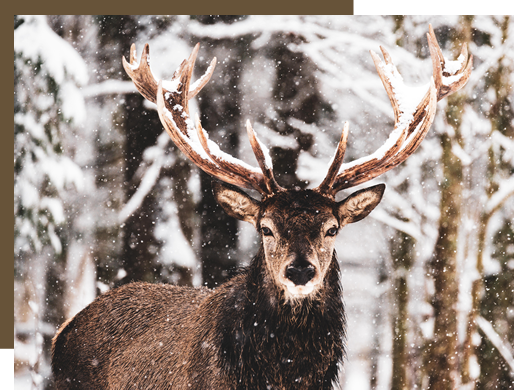
If a grown up in a Jeep racing a toddler with a Hot Wheel is considered a fair competition, then maybe hunting is a “sport” after all. Although sports usually involve a fair chance of either party winning. So when modern hunting involves rifles, traps, and enclosed areas that animals can’t escape, we have to wonder if hunting is really a sport and not something more sinister.
Research shows that most hunting that occurs today is not for food or survival, but for the trophies of dead animals and the thrill of killing. When a human kills other humans, we label them a violent criminal. When a person does the same thing to animals, we might label them a sportsman. Real athletes sweat and train, practice and practice, and test their endurance and grit against the challenges of their sport. Some hunters go on canned hunts where they pay tons of money to visit an animal reserve. These aren’t sports arenas but miserable places where creatures like lions and tigers and bears have been drugged and locked inside enclosed areas they can’t escape. The “sport” is essentially pulling a trigger, killing an intelligent and powerful creature, and then posing for a picture next to the corpse before turning the skin into a rug. Sounds like quite the workout. For your wallet and your privilege.
The truth is modern hunting culture has more to do with the mythology of humans conquering nature rather than a respect for the life and death we all experience in the animal kingdom. Some hunters claim that the real purpose of hunting is to control animal populations in order to keep ecosystems in balance. This ignores the fact that hunting and poaching have pushed countless species to the brink of extinction, disrupting ecosystems in ways we can only begin to imagine. There are endless ways we can collectively work together to save species from the brink of extinction, but hanging animal heads on our walls is not one of those ways. If you still feel the inherent need to be stronger and more fatal than a wild creature, you can always hop in your Jeep and race a toddler and their Hot Wheel. Hope you don’t break a sweat.
Aquatic: Diving Deep
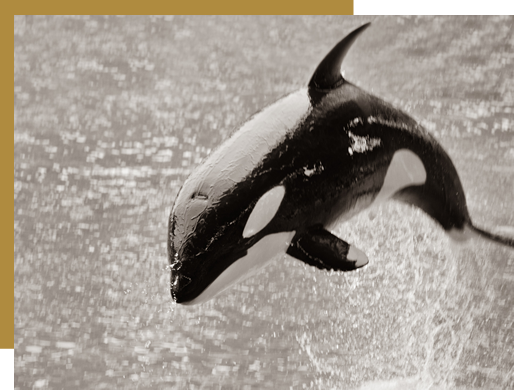
At Feet of My People, we have a simple test for determining if certain practices and industries exhibit animal cruelty. We call it the alien species test, and it may make it hard to enjoy the things you once enjoyed.
Imagine an alien species lands on Earth, and they find human beings to be cute and entertaining but rather unintelligent creatures. The aliens realize that if they take us from our homes and our loved ones, place us in captivity, and deprive us of food in order to teach us unnatural tricks like hopping backwards on our butts or snapping our heads in circles, they can make loads of money showing their other alien friends how well trained and “happy” we are. In reality, we would be depressed and broken beyond belief.
While some people who genuinely love animals still visit aquariums and marine animal shows, the truth is the beautiful creatures we’re admiring do not want to be performing for us. They want to be home. For a human, home might be where the Netflix, blankets, and snack foods are. For marine animals like whales and dolphins, home is the infinite ocean. Home is the pod of your family members, singing ancient songs through the deep blue. Home is playing, exploring, and creating deep and lasting relationships with your kind. It’s not clapping your flippers together for a bucket of dead fish. Well-meaning people might believe that marine animal shows like SeaWorld are meant to inspire us to better protect the environment and our marine counterparts. In reality, SeaWorld has unethical means of stealing these majestic creatures from their native homes, depriving them of their social lives and sense of adventure, and turning their images into stuffed animals and postcards while the real animals languish in captivity.
If we really love animals, we can make the conscious, ethical effort of learning about them in their natural habitat. Instead of shrinking their world down to a chlorinated pool, let’s expand our world to the depths of the ocean. If the aliens came to rip us away from our Netflix and blankets and snacks, we would mourn the world we lost. Every time we take a marine animal away from the splendor and freedom of the ocean, the Earth loses a bit of magic.
Planet Earth is a Party
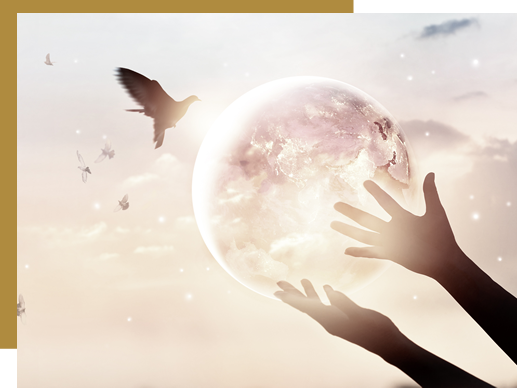
Imagine this: Your name is Earth and you’re getting ready to throw a huge house party. You pull out all the stops. You decorate the place with oceans, mountains, forests, deserts, rivers, and lakes to entertain your guests. You engineer plants that can produce their own food from sunlight, and in turn, the plants provide incredible nourishment and flavor to anyone who eats them. Your buffet table is overflowing with endless goodies. And what’s a party without music, right? So you invite whales because you know their underwater melody will get your guests bumping and grooving. You don’t stop there though, you send out invites to the birds, elephants, wild cats, wolves, reptiles, invertebrates, insects, and countless creatures who each make their own music and celebrate their own distinct culture. It’s finally time to get this party started! One problem though: your party gets crashed by the rudest house guest of them all. Humans.
Humans pull up to your crib and instantly start making a mess. They’re cutting down forests you just planted to build a bigger bonfire. They’re peeing in the ocean and filling it with empty soda cans and plastic packaging. They keep bragging about all the cool party tricks they can do, but they don’t realize that the party is dying down all around them. Humans won’t stop harassing your other guests, stealing their habitats, putting them into captivity, killing them en masse. When a drunk guy starts showing off his taxidermied lion, you realize it’s time to call this party quits. You didn’t go through all the effort of creating a magnificent lion just for it be stuffed like a piñata and shown off like a party favor. That’s it. Lights on. It’s time to go home.
Earth is the only home we have ever known. Yet humans have collectively treated their terrestrial home with all the respect a fraternity brother pays his chapter house. Yeah, the smell of it all is kinda gross, and you wonder how long it’s been since the toilet was last cleaned. While there are other territorial and deadly animals, no other species has reshaped the world the way that humans have. With our pollution, deforestation, factory farming, oil spills, and pipelines, humans have threatened the delicate balance of nature and wreaked havoc on ecosystems all over the planet. Along with the destruction of our home planet, preventable illnesses, depression, anxiety, and cancer have meteorically risen, reducing our quality of life.
If we care about protecting animals and their rights, we also have to care about the health of the water, land, and air that gives them life. Every form of cruelty intersects with other forms, which is why our power to make compassionate choices can have a ripple effect. Making kind, informed decisions about our food, clothing, household purchases, and entertainment can ensure that people, animals, and the environment are all respected and protected. We have to look out for each other. Our choices begin as individual acts, but by sharing stories, actively listening to each other, creating art and humor, and being open, we can start to collectively shift away from old models of oppression and move as a community into a new world of kindness and respect.
Slowly but surely, people are waking up and shaking off the hangover of bad planet etiquette. We’re cleaning up last night’s mess. We’re sobering up to the hard work ahead and taking joy in it. We’re unlearning the ways we were taught to be mindless consumers and destroyers, and we’re learning new ways of being the life of the party. Imagine this: being born on this incredibly diverse planet is a privilege, a responsibility, and an endless celebration of life. And you’re invited.

